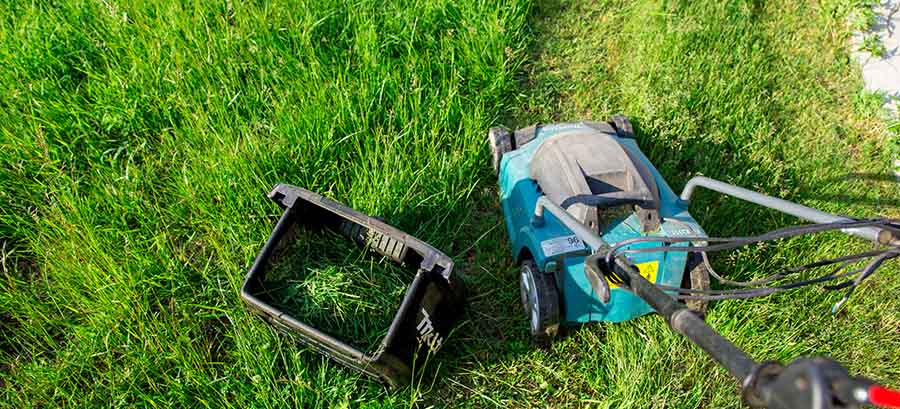If you have ever had to mow a lawn and put the bag up the clippings, you know that it can be the most challenging part of mowing a lawn. Thankfully, the bag isn’t always required. From having to get the bag in place correctly to detaching and reattaching your catch, it can be not very pleasant to do over and over.
You can forgo the clippings catcher, or the bag, on your lawnmower. To use your lawnmower without the bag, you can have the clippings redistributed into the yard via mulching. Or, you can use the side discharge on your mower to blow them out into the lawn.
While the process of using your lawnmower without a bag may seem straightforward, there are some aspects that you need to consider to keep yourself safe and to help your lawn. Properly using your mower without the bag can yield excellent results for your lawn, but doing so improperly could seriously harm your lawn or your person. To make sure you do it properly read on.
Using a Lawnmower Without the Bag

If you are planning on using your mower without the bag, you may be wondering what other options there are. There are two primary options outside of bags that most people use: mulching and side discharge.
Each of these come with their benefits and deficits, just like bagging does. So, let us go over those.
The Good and Bad of Side Discharge
Side discharge was perhaps the most common type of lawnmower before the bag became the standard for homeowners. Side discharge is still widespread, though, especially amongst professionals.
The main appeal of side discharge is the nutrients it cycles back into your lawn. Some people have raised concerns that lawn clippings left out result in higher levels of thatch, but studies have shown that is not the case. The leading cause of thatch is poor aeration, over-fertilizing, and too much pesticide.
Lawn clippings that are cut to the proper size can recycle nitrogen back into your lawn and encourage microorganisms and earthworms to decompose the clipping into additional nutrients for your lawn.
This recycling is not only great for your lawn but can also save you money by lowering the amount of fertilizer you need to purchase. However, some issues arise with side discharge.
The primary one is that the lawn clippings can cause a mess. If you have neighbors or a small yard, you may end up leaving clippings in places they are unwanted such as your neighbor’s yard or the road.
Additionally, you will need to make sure your blade height is correct to ensure you are getting the proper size of lawn clipping needed to help your lawn. The last thing to consider with side discharge is speed.
Side discharge allows you to go through your grass very quickly, which can be a great benefit if you want to get the yard done.
The Good and Bad of Mulching
Mulching, like the side-discharge method, is desired for its ability to redistribute your lawn clippings into your lawn. However, the difference here is that your lawn clippings are not shot out of a side port.
Instead, they are cycled around where the blade is located and dropped back onto the ground. This means you get the benefit of side discharge without having to worry about upsetting your neighbors or making a mess.
However, mulching comes with its problems. For starters, you will need a particular mulching mower for this.
So, if you plan on mulching your lawn, keep in mind that you will need to purchase a mower specifically for it, and replacement blades will also need to be mulching blades.
Additionally, you will still need to make sure you are cutting your clippings to the proper length.
By the way, the robotic lawn mowers that are becoming more and more popular use mulching. Cutting your lawn regularly with one of these prevents weeds and recycles the clippings naturally.
The video below is a great resource and explains the pros and cons very well.
The Bagless Process
Now that you know your options, it is time to cover the process you will need to follow to ensure you are getting the best results from using your lawnmower without the bag.
As stated earlier, if you want to go the mulching route, you will need a particular mulching lawnmower, but if you plan on going the side-discharge route, you will only need an adapter.
However, regardless of which method you choose, there are some basic rules to follow to make sure your lawn stays healthy. Let’s go over those, and then we will cover how to modify your mower to fit a side discharger.
Basic Rules to Follow if You’re Not Bagging
I have mentioned that you will need to make sure your lawn clippings are the proper size a few times in this article, and you may be wondering what that size is.
The answer will depend on what type of grass you have and what season it is. In spring, when your grass first arrives, you will want to cut your grass at least once a week and make sure that your clippings are no more than 1″ in size.
If your clippings are more extensive than this, be sure to mow more regularly to break them up and keep them from clumping. Cutting your grass shorter in the spring results in a greener yard and reduces the risk of thatch forming.
As the year progresses, you will want to adjust your blade height to get longer blade clippings over time. Eventually, in the fall, you will want your blade clippings to be around 2″ to 2 ½” in size.
Throughout the whole year, however, you must keep your blades sharp. Doing so will ensure you are getting clean cuts and will prevent the grass from becoming diseased.
Modifying your Mower for Side Discharge
Most mowers will be easily modified to fit a side discharge. However, the exact method of doing so will differ depending on your specific mower.
To make sure you do it correctly and that you get an attachment that fits, I recommend looking at the instructions and manual for your mower, or if you do not have access to this, contacting the manufacturer of your mower.
The main things you will need to look for is a plate on the side of your mower that can be removed by removing a few bolts or can be lifted.
Once you have removed or lifted this side panel, you will have access to the blade. You should make sure your mower is off before doing this. Next, you will attach the side discharger through the designated method.
This will probably be through attaching the bolts onto it or merely hooking it into place. The other thing you will need to consider is the place where your bag was attached to. You will need to place a plug or plate designated for your mower to keep the clippings from flying out onto you.
With that, you can start mowing your lawn and reaping the benefits of recycling your grass.
Why Use a Lawnmower without a Bag?
Bagging is perhaps the most common method of lawnmower currently for homeowners. The reason that bagging is a great option is that it will pick up whatever is in your lawn and put it in one place.
Additionally, by bagging it, you will not need to worry about making sure your clippings are a specific size like you will with mulching and side discharge. If you have neighbors or a small area, bagging can be a great way to contain clippings from going everywhere.
However, once you have collected the clippings, you have the issue of having a whole catcher bag full of clippings to dispose of.
There are a few options for what you can do with your lawn clippings. Some people will put them in a compost bin to use as fertilizer for their flower beds. However, along with all the other options for disposing of lawn clippings, there is a lot of extra work that comes with bagging.
Besides composting, you can also redistribute your lawn clippings over your yard, but if you do so, you will need to make sure your clippings are the appropriate size to avoid damage to your lawn. Of course, there is the option of simply throwing your clippings away, but this is the most damaging to the environment and gives you none of the benefits.

